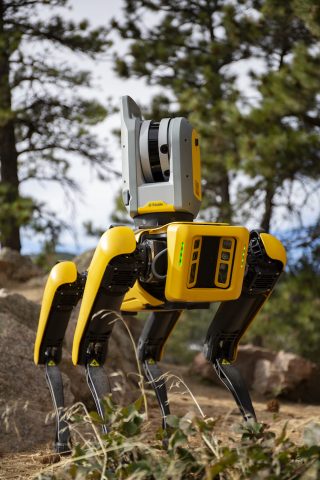
Trimble, Hilti and robot maker Boston Dynamics join forces to build autonomous construction robot
By On-Site Staff
Software
A Boston Dynamics Spot Robot equipped with a laser scanning system capable of carrying out a wide range of readings. PHOTO: Trimble
Three companies with relatively distinct specialties are teaming up to build an autonomous construction robot.
Trimble Inc., Hilti Corp. and Boston Dynamics said Nov. 19 they’ve agreed to work together to develop a proof-of-concept machine capable of taking on simple job site tasks. The two construction-oriented firms plan to integrate a number of their reality capture technologies and software solutions with the MIT spin-off’s Spot Robot.
“Utilizing robots for routine tasks in hazardous environments to improve safety, efficiency, and data capture consistency is part of our digital transformation vision” said Aviad Almagor, senior director for Mixed Reality and Brain-Computer Interface (BCI) at Trimble, in a release.
The partnership hinges on Boston Dynamics’ Spot Robot platform, which the company promotes as a “nimble robot that climbs stairs and traverses rough terrain with unprecedented ease.” It’s also built to be rugged and customizable — two traits seen as essential to any sort of autonomous technology functioning on the construction industry’s vast array of unique job sites.
Related: Assessing the future: Job site robotics are quickly gaining ground
Michael Perry, vice president of Business Development at Boston Dynamics, said Trimble’s and Hilti’s existing technologies are a “great fit” for the platform.
“Deploying an integrated solution in the real-world environment doing dirty and dangerous work, before, during and after the construction stage is a common vision for the three companies, which can help drive the transformation of the construction industry,” he said in a release.
Equipped with hardware and software from the trio of companies, the robot will be designed to take on repeatable jobs — daily job site scans, progress monitoring and asset management, for instance. While it won’t directly take part in the building process like other emerging robotic technologies, such as the brick-laying SAM (Semi-Automated Mason) or Tybot, a machine that automates the tedious task of tying large numbers of rebar intersections, it would fill in for human workers in a key area. As tech adoption in the construction industry advances, data collection and analytics is expected to play an ever larger role.




